Managing People in Health and Social Care: A Comprehensive Overview
VerifiedAdded on 2023/06/07
|12
|3668
|233
Report
AI Summary
This report provides a comprehensive overview of managing people in health and social care. It delves into the recruitment and selection processes, including factors influencing planning, specialist expertise requirements, and the impact of legislative and regulatory frameworks like the Equality Act 2010 and the Immigration, Asylum and Nationality Act 2006. The report also examines training and career development opportunities, emphasizing performance management solutions for individual and group enhancement, along with techniques for monitoring performance and identifying training needs. Furthermore, it explores strategies for managing a diverse workforce, highlighting the importance of cultural diversity and evaluating different approaches to foster an inclusive environment. The report emphasizes the significance of continuous professional development (CPD) and its role in enhancing healthcare professionals' skills and ensuring public health safety.
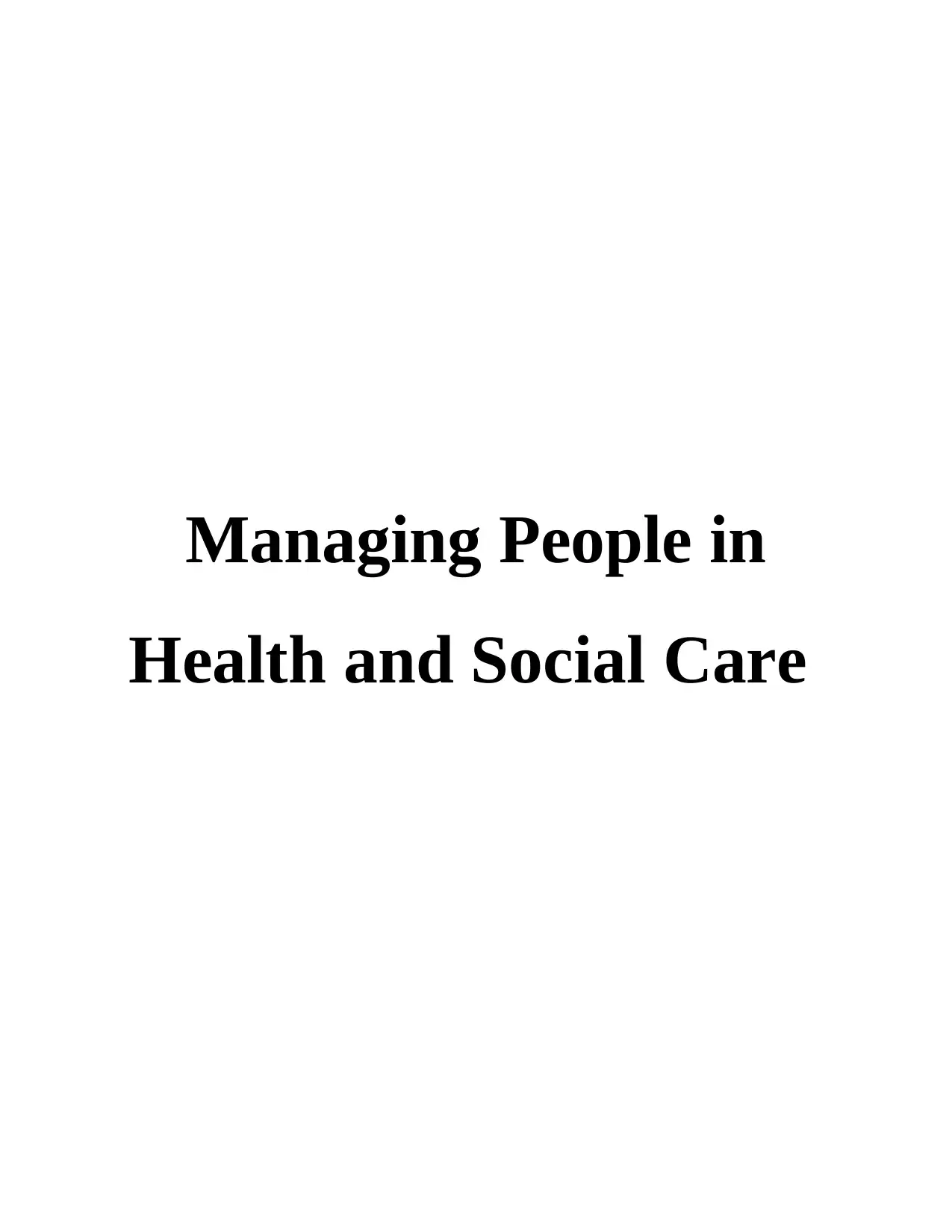
Managing People in
Health and Social Care
Health and Social Care
Paraphrase This Document
Need a fresh take? Get an instant paraphrase of this document with our AI Paraphraser
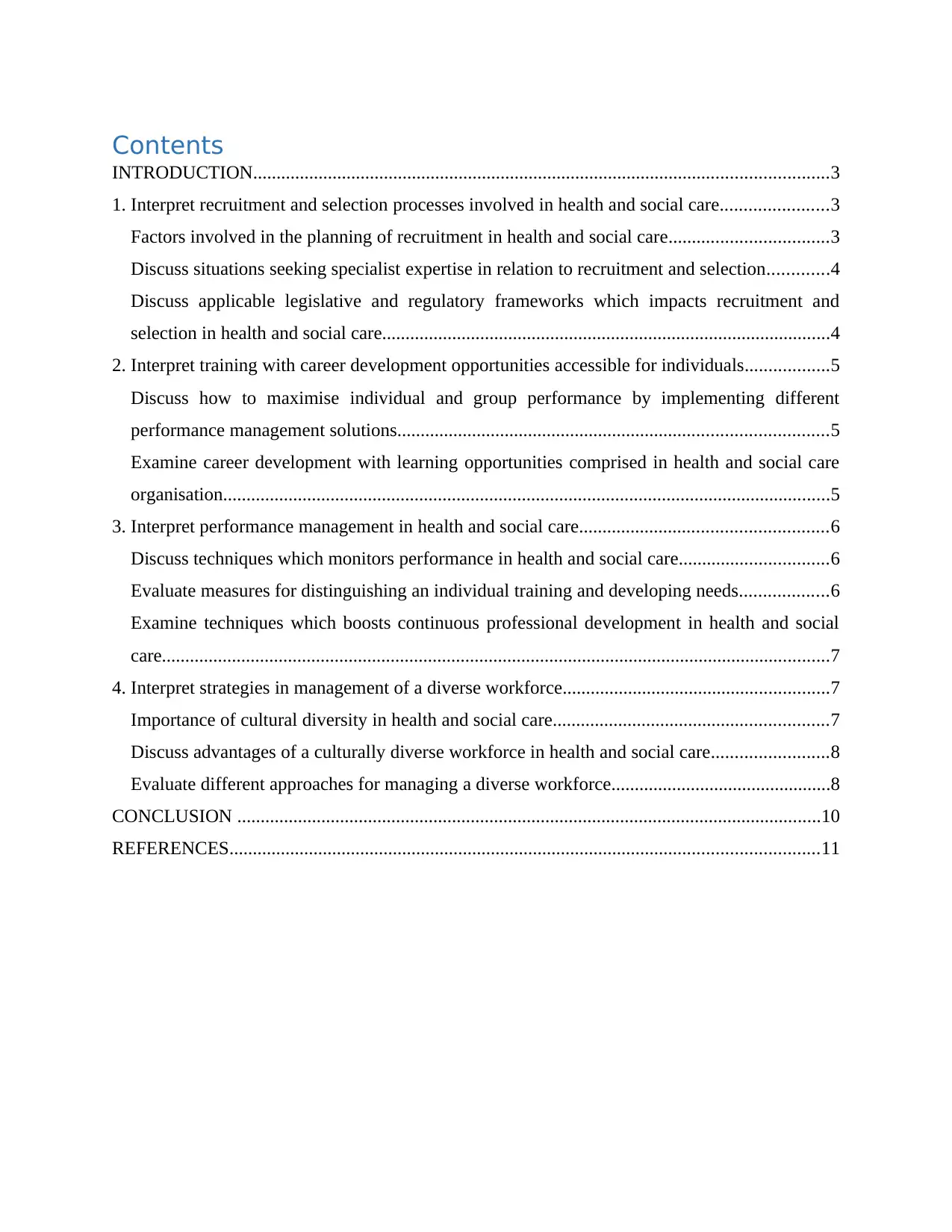
Contents
INTRODUCTION...........................................................................................................................3
1. Interpret recruitment and selection processes involved in health and social care.......................3
Factors involved in the planning of recruitment in health and social care..................................3
Discuss situations seeking specialist expertise in relation to recruitment and selection.............4
Discuss applicable legislative and regulatory frameworks which impacts recruitment and
selection in health and social care................................................................................................4
2. Interpret training with career development opportunities accessible for individuals..................5
Discuss how to maximise individual and group performance by implementing different
performance management solutions............................................................................................5
Examine career development with learning opportunities comprised in health and social care
organisation..................................................................................................................................5
3. Interpret performance management in health and social care.....................................................6
Discuss techniques which monitors performance in health and social care................................6
Evaluate measures for distinguishing an individual training and developing needs...................6
Examine techniques which boosts continuous professional development in health and social
care...............................................................................................................................................7
4. Interpret strategies in management of a diverse workforce.........................................................7
Importance of cultural diversity in health and social care...........................................................7
Discuss advantages of a culturally diverse workforce in health and social care.........................8
Evaluate different approaches for managing a diverse workforce...............................................8
CONCLUSION .............................................................................................................................10
REFERENCES..............................................................................................................................11
INTRODUCTION...........................................................................................................................3
1. Interpret recruitment and selection processes involved in health and social care.......................3
Factors involved in the planning of recruitment in health and social care..................................3
Discuss situations seeking specialist expertise in relation to recruitment and selection.............4
Discuss applicable legislative and regulatory frameworks which impacts recruitment and
selection in health and social care................................................................................................4
2. Interpret training with career development opportunities accessible for individuals..................5
Discuss how to maximise individual and group performance by implementing different
performance management solutions............................................................................................5
Examine career development with learning opportunities comprised in health and social care
organisation..................................................................................................................................5
3. Interpret performance management in health and social care.....................................................6
Discuss techniques which monitors performance in health and social care................................6
Evaluate measures for distinguishing an individual training and developing needs...................6
Examine techniques which boosts continuous professional development in health and social
care...............................................................................................................................................7
4. Interpret strategies in management of a diverse workforce.........................................................7
Importance of cultural diversity in health and social care...........................................................7
Discuss advantages of a culturally diverse workforce in health and social care.........................8
Evaluate different approaches for managing a diverse workforce...............................................8
CONCLUSION .............................................................................................................................10
REFERENCES..............................................................................................................................11
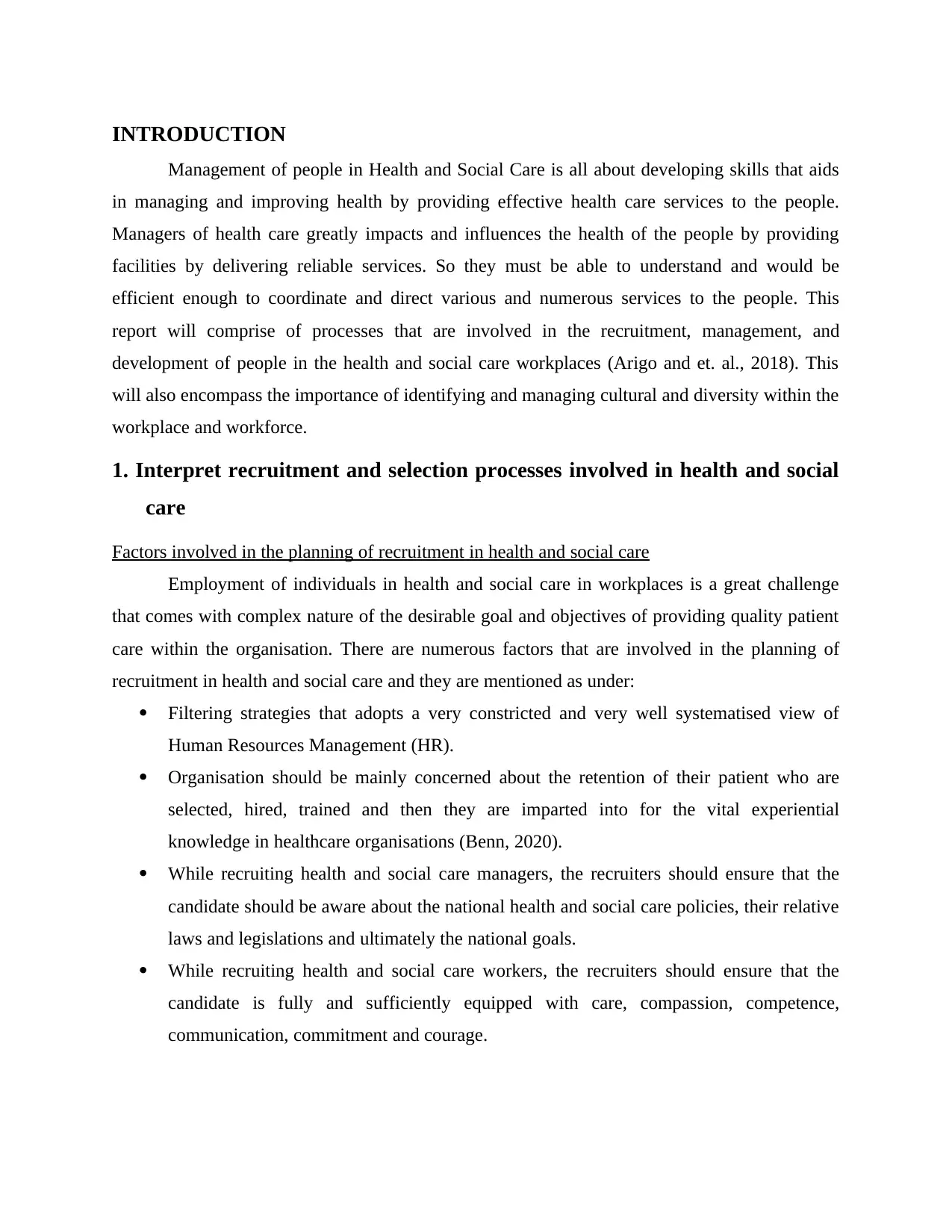
INTRODUCTION
Management of people in Health and Social Care is all about developing skills that aids
in managing and improving health by providing effective health care services to the people.
Managers of health care greatly impacts and influences the health of the people by providing
facilities by delivering reliable services. So they must be able to understand and would be
efficient enough to coordinate and direct various and numerous services to the people. This
report will comprise of processes that are involved in the recruitment, management, and
development of people in the health and social care workplaces (Arigo and et. al., 2018). This
will also encompass the importance of identifying and managing cultural and diversity within the
workplace and workforce.
1. Interpret recruitment and selection processes involved in health and social
care
Factors involved in the planning of recruitment in health and social care
Employment of individuals in health and social care in workplaces is a great challenge
that comes with complex nature of the desirable goal and objectives of providing quality patient
care within the organisation. There are numerous factors that are involved in the planning of
recruitment in health and social care and they are mentioned as under:
Filtering strategies that adopts a very constricted and very well systematised view of
Human Resources Management (HR).
Organisation should be mainly concerned about the retention of their patient who are
selected, hired, trained and then they are imparted into for the vital experiential
knowledge in healthcare organisations (Benn, 2020).
While recruiting health and social care managers, the recruiters should ensure that the
candidate should be aware about the national health and social care policies, their relative
laws and legislations and ultimately the national goals.
While recruiting health and social care workers, the recruiters should ensure that the
candidate is fully and sufficiently equipped with care, compassion, competence,
communication, commitment and courage.
Management of people in Health and Social Care is all about developing skills that aids
in managing and improving health by providing effective health care services to the people.
Managers of health care greatly impacts and influences the health of the people by providing
facilities by delivering reliable services. So they must be able to understand and would be
efficient enough to coordinate and direct various and numerous services to the people. This
report will comprise of processes that are involved in the recruitment, management, and
development of people in the health and social care workplaces (Arigo and et. al., 2018). This
will also encompass the importance of identifying and managing cultural and diversity within the
workplace and workforce.
1. Interpret recruitment and selection processes involved in health and social
care
Factors involved in the planning of recruitment in health and social care
Employment of individuals in health and social care in workplaces is a great challenge
that comes with complex nature of the desirable goal and objectives of providing quality patient
care within the organisation. There are numerous factors that are involved in the planning of
recruitment in health and social care and they are mentioned as under:
Filtering strategies that adopts a very constricted and very well systematised view of
Human Resources Management (HR).
Organisation should be mainly concerned about the retention of their patient who are
selected, hired, trained and then they are imparted into for the vital experiential
knowledge in healthcare organisations (Benn, 2020).
While recruiting health and social care managers, the recruiters should ensure that the
candidate should be aware about the national health and social care policies, their relative
laws and legislations and ultimately the national goals.
While recruiting health and social care workers, the recruiters should ensure that the
candidate is fully and sufficiently equipped with care, compassion, competence,
communication, commitment and courage.
⊘ This is a preview!⊘
Do you want full access?
Subscribe today to unlock all pages.

Trusted by 1+ million students worldwide
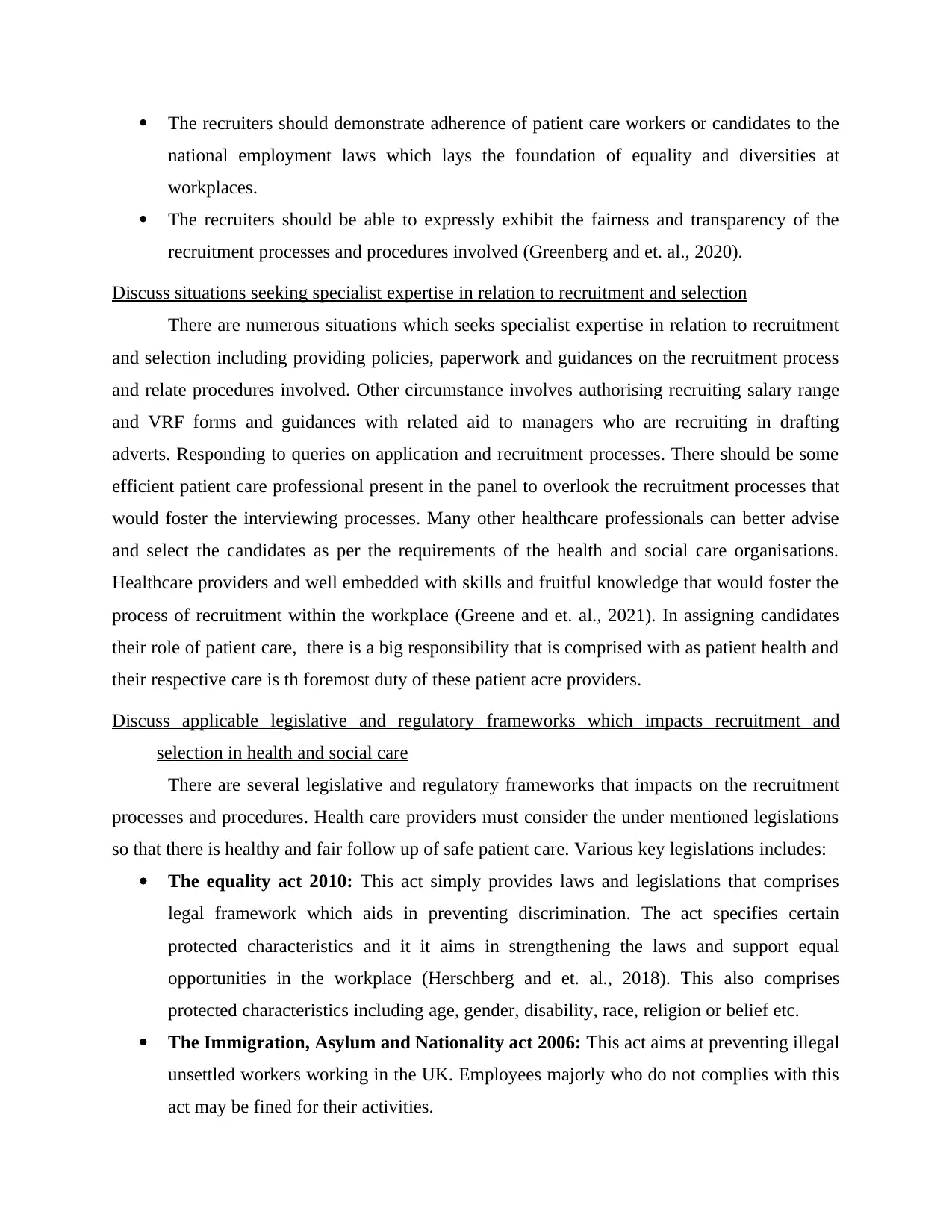
The recruiters should demonstrate adherence of patient care workers or candidates to the
national employment laws which lays the foundation of equality and diversities at
workplaces.
The recruiters should be able to expressly exhibit the fairness and transparency of the
recruitment processes and procedures involved (Greenberg and et. al., 2020).
Discuss situations seeking specialist expertise in relation to recruitment and selection
There are numerous situations which seeks specialist expertise in relation to recruitment
and selection including providing policies, paperwork and guidances on the recruitment process
and relate procedures involved. Other circumstance involves authorising recruiting salary range
and VRF forms and guidances with related aid to managers who are recruiting in drafting
adverts. Responding to queries on application and recruitment processes. There should be some
efficient patient care professional present in the panel to overlook the recruitment processes that
would foster the interviewing processes. Many other healthcare professionals can better advise
and select the candidates as per the requirements of the health and social care organisations.
Healthcare providers and well embedded with skills and fruitful knowledge that would foster the
process of recruitment within the workplace (Greene and et. al., 2021). In assigning candidates
their role of patient care, there is a big responsibility that is comprised with as patient health and
their respective care is th foremost duty of these patient acre providers.
Discuss applicable legislative and regulatory frameworks which impacts recruitment and
selection in health and social care
There are several legislative and regulatory frameworks that impacts on the recruitment
processes and procedures. Health care providers must consider the under mentioned legislations
so that there is healthy and fair follow up of safe patient care. Various key legislations includes:
The equality act 2010: This act simply provides laws and legislations that comprises
legal framework which aids in preventing discrimination. The act specifies certain
protected characteristics and it it aims in strengthening the laws and support equal
opportunities in the workplace (Herschberg and et. al., 2018). This also comprises
protected characteristics including age, gender, disability, race, religion or belief etc.
The Immigration, Asylum and Nationality act 2006: This act aims at preventing illegal
unsettled workers working in the UK. Employees majorly who do not complies with this
act may be fined for their activities.
national employment laws which lays the foundation of equality and diversities at
workplaces.
The recruiters should be able to expressly exhibit the fairness and transparency of the
recruitment processes and procedures involved (Greenberg and et. al., 2020).
Discuss situations seeking specialist expertise in relation to recruitment and selection
There are numerous situations which seeks specialist expertise in relation to recruitment
and selection including providing policies, paperwork and guidances on the recruitment process
and relate procedures involved. Other circumstance involves authorising recruiting salary range
and VRF forms and guidances with related aid to managers who are recruiting in drafting
adverts. Responding to queries on application and recruitment processes. There should be some
efficient patient care professional present in the panel to overlook the recruitment processes that
would foster the interviewing processes. Many other healthcare professionals can better advise
and select the candidates as per the requirements of the health and social care organisations.
Healthcare providers and well embedded with skills and fruitful knowledge that would foster the
process of recruitment within the workplace (Greene and et. al., 2021). In assigning candidates
their role of patient care, there is a big responsibility that is comprised with as patient health and
their respective care is th foremost duty of these patient acre providers.
Discuss applicable legislative and regulatory frameworks which impacts recruitment and
selection in health and social care
There are several legislative and regulatory frameworks that impacts on the recruitment
processes and procedures. Health care providers must consider the under mentioned legislations
so that there is healthy and fair follow up of safe patient care. Various key legislations includes:
The equality act 2010: This act simply provides laws and legislations that comprises
legal framework which aids in preventing discrimination. The act specifies certain
protected characteristics and it it aims in strengthening the laws and support equal
opportunities in the workplace (Herschberg and et. al., 2018). This also comprises
protected characteristics including age, gender, disability, race, religion or belief etc.
The Immigration, Asylum and Nationality act 2006: This act aims at preventing illegal
unsettled workers working in the UK. Employees majorly who do not complies with this
act may be fined for their activities.
Paraphrase This Document
Need a fresh take? Get an instant paraphrase of this document with our AI Paraphraser
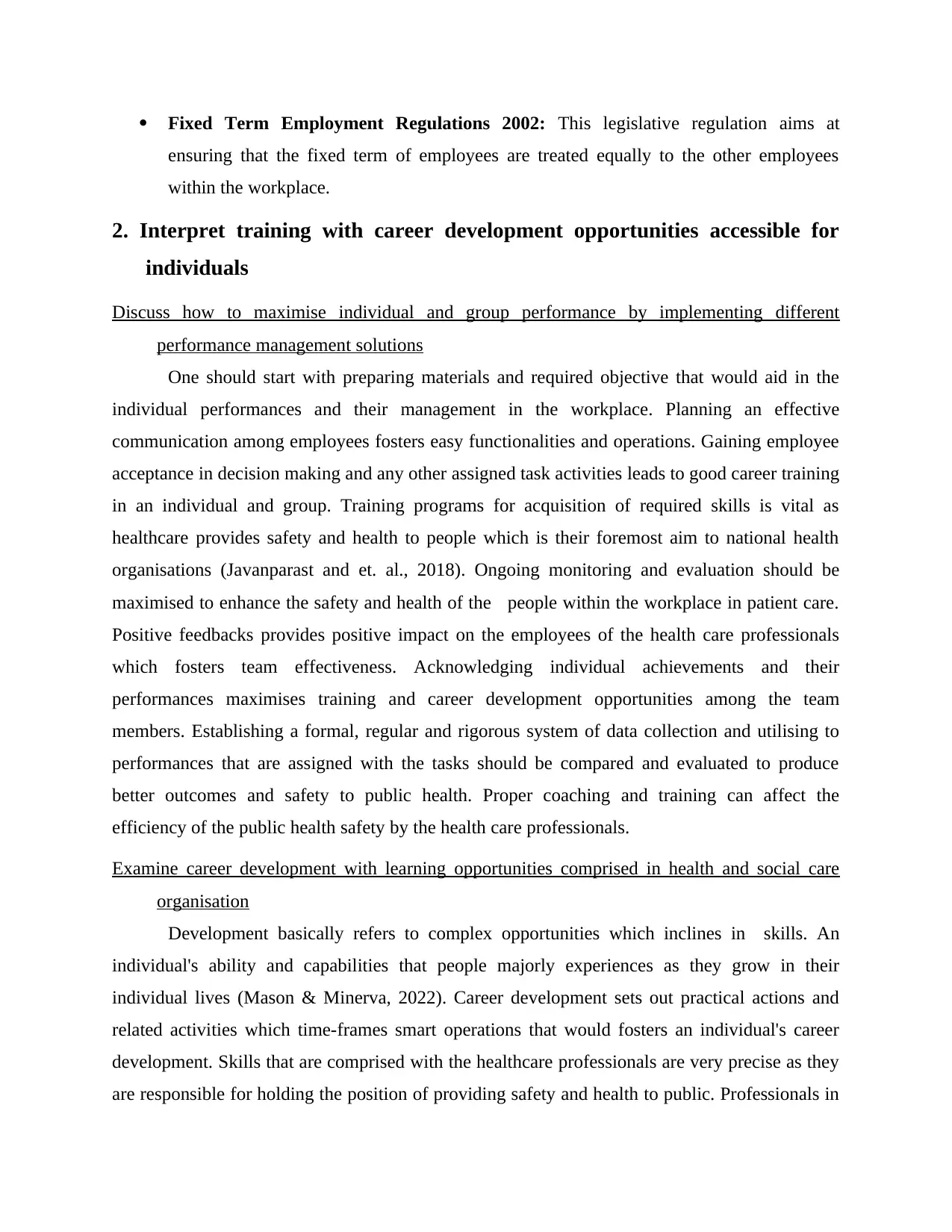
Fixed Term Employment Regulations 2002: This legislative regulation aims at
ensuring that the fixed term of employees are treated equally to the other employees
within the workplace.
2. Interpret training with career development opportunities accessible for
individuals
Discuss how to maximise individual and group performance by implementing different
performance management solutions
One should start with preparing materials and required objective that would aid in the
individual performances and their management in the workplace. Planning an effective
communication among employees fosters easy functionalities and operations. Gaining employee
acceptance in decision making and any other assigned task activities leads to good career training
in an individual and group. Training programs for acquisition of required skills is vital as
healthcare provides safety and health to people which is their foremost aim to national health
organisations (Javanparast and et. al., 2018). Ongoing monitoring and evaluation should be
maximised to enhance the safety and health of the people within the workplace in patient care.
Positive feedbacks provides positive impact on the employees of the health care professionals
which fosters team effectiveness. Acknowledging individual achievements and their
performances maximises training and career development opportunities among the team
members. Establishing a formal, regular and rigorous system of data collection and utilising to
performances that are assigned with the tasks should be compared and evaluated to produce
better outcomes and safety to public health. Proper coaching and training can affect the
efficiency of the public health safety by the health care professionals.
Examine career development with learning opportunities comprised in health and social care
organisation
Development basically refers to complex opportunities which inclines in skills. An
individual's ability and capabilities that people majorly experiences as they grow in their
individual lives (Mason & Minerva, 2022). Career development sets out practical actions and
related activities which time-frames smart operations that would fosters an individual's career
development. Skills that are comprised with the healthcare professionals are very precise as they
are responsible for holding the position of providing safety and health to public. Professionals in
ensuring that the fixed term of employees are treated equally to the other employees
within the workplace.
2. Interpret training with career development opportunities accessible for
individuals
Discuss how to maximise individual and group performance by implementing different
performance management solutions
One should start with preparing materials and required objective that would aid in the
individual performances and their management in the workplace. Planning an effective
communication among employees fosters easy functionalities and operations. Gaining employee
acceptance in decision making and any other assigned task activities leads to good career training
in an individual and group. Training programs for acquisition of required skills is vital as
healthcare provides safety and health to people which is their foremost aim to national health
organisations (Javanparast and et. al., 2018). Ongoing monitoring and evaluation should be
maximised to enhance the safety and health of the people within the workplace in patient care.
Positive feedbacks provides positive impact on the employees of the health care professionals
which fosters team effectiveness. Acknowledging individual achievements and their
performances maximises training and career development opportunities among the team
members. Establishing a formal, regular and rigorous system of data collection and utilising to
performances that are assigned with the tasks should be compared and evaluated to produce
better outcomes and safety to public health. Proper coaching and training can affect the
efficiency of the public health safety by the health care professionals.
Examine career development with learning opportunities comprised in health and social care
organisation
Development basically refers to complex opportunities which inclines in skills. An
individual's ability and capabilities that people majorly experiences as they grow in their
individual lives (Mason & Minerva, 2022). Career development sets out practical actions and
related activities which time-frames smart operations that would fosters an individual's career
development. Skills that are comprised with the healthcare professionals are very precise as they
are responsible for holding the position of providing safety and health to public. Professionals in
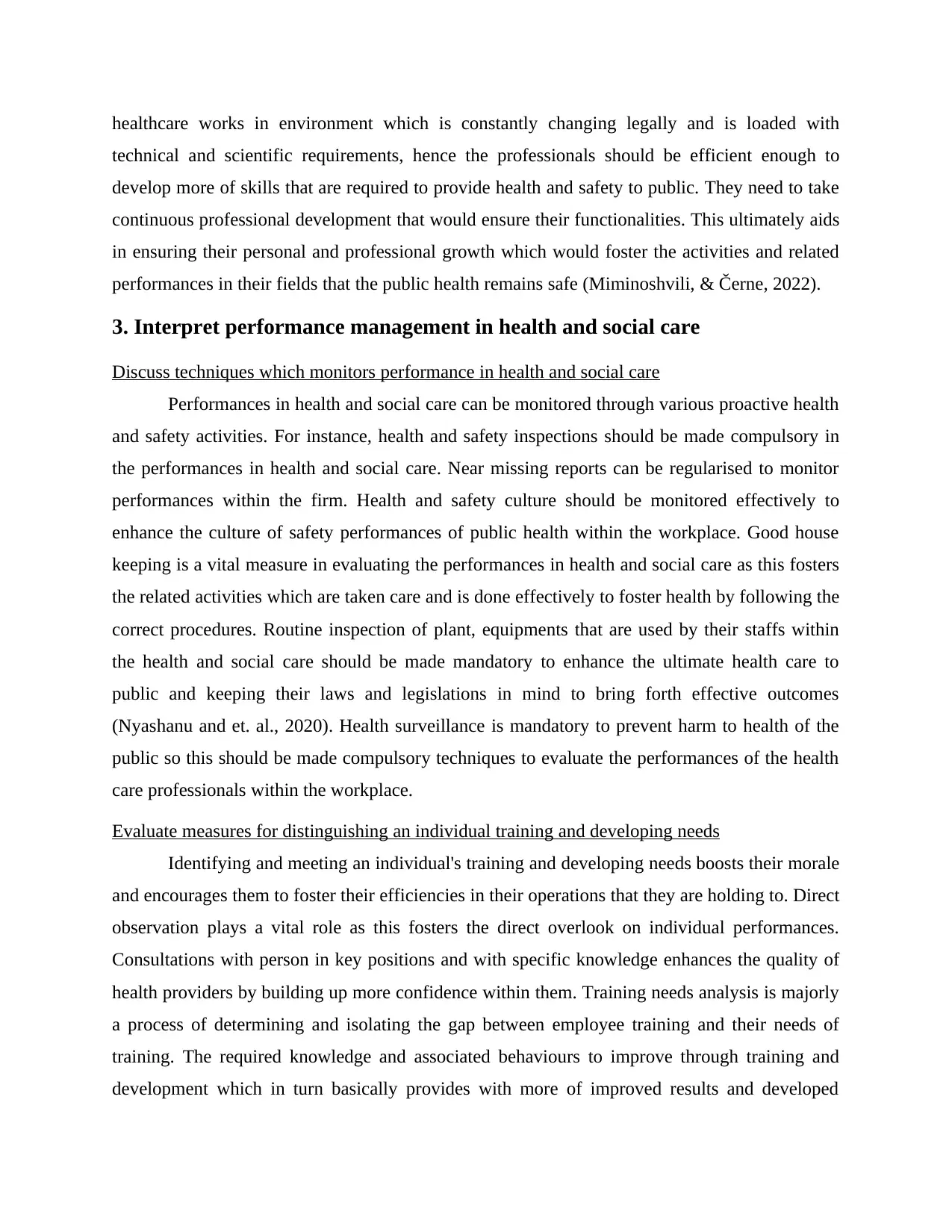
healthcare works in environment which is constantly changing legally and is loaded with
technical and scientific requirements, hence the professionals should be efficient enough to
develop more of skills that are required to provide health and safety to public. They need to take
continuous professional development that would ensure their functionalities. This ultimately aids
in ensuring their personal and professional growth which would foster the activities and related
performances in their fields that the public health remains safe (Miminoshvili, & Černe, 2022).
3. Interpret performance management in health and social care
Discuss techniques which monitors performance in health and social care
Performances in health and social care can be monitored through various proactive health
and safety activities. For instance, health and safety inspections should be made compulsory in
the performances in health and social care. Near missing reports can be regularised to monitor
performances within the firm. Health and safety culture should be monitored effectively to
enhance the culture of safety performances of public health within the workplace. Good house
keeping is a vital measure in evaluating the performances in health and social care as this fosters
the related activities which are taken care and is done effectively to foster health by following the
correct procedures. Routine inspection of plant, equipments that are used by their staffs within
the health and social care should be made mandatory to enhance the ultimate health care to
public and keeping their laws and legislations in mind to bring forth effective outcomes
(Nyashanu and et. al., 2020). Health surveillance is mandatory to prevent harm to health of the
public so this should be made compulsory techniques to evaluate the performances of the health
care professionals within the workplace.
Evaluate measures for distinguishing an individual training and developing needs
Identifying and meeting an individual's training and developing needs boosts their morale
and encourages them to foster their efficiencies in their operations that they are holding to. Direct
observation plays a vital role as this fosters the direct overlook on individual performances.
Consultations with person in key positions and with specific knowledge enhances the quality of
health providers by building up more confidence within them. Training needs analysis is majorly
a process of determining and isolating the gap between employee training and their needs of
training. The required knowledge and associated behaviours to improve through training and
development which in turn basically provides with more of improved results and developed
technical and scientific requirements, hence the professionals should be efficient enough to
develop more of skills that are required to provide health and safety to public. They need to take
continuous professional development that would ensure their functionalities. This ultimately aids
in ensuring their personal and professional growth which would foster the activities and related
performances in their fields that the public health remains safe (Miminoshvili, & Černe, 2022).
3. Interpret performance management in health and social care
Discuss techniques which monitors performance in health and social care
Performances in health and social care can be monitored through various proactive health
and safety activities. For instance, health and safety inspections should be made compulsory in
the performances in health and social care. Near missing reports can be regularised to monitor
performances within the firm. Health and safety culture should be monitored effectively to
enhance the culture of safety performances of public health within the workplace. Good house
keeping is a vital measure in evaluating the performances in health and social care as this fosters
the related activities which are taken care and is done effectively to foster health by following the
correct procedures. Routine inspection of plant, equipments that are used by their staffs within
the health and social care should be made mandatory to enhance the ultimate health care to
public and keeping their laws and legislations in mind to bring forth effective outcomes
(Nyashanu and et. al., 2020). Health surveillance is mandatory to prevent harm to health of the
public so this should be made compulsory techniques to evaluate the performances of the health
care professionals within the workplace.
Evaluate measures for distinguishing an individual training and developing needs
Identifying and meeting an individual's training and developing needs boosts their morale
and encourages them to foster their efficiencies in their operations that they are holding to. Direct
observation plays a vital role as this fosters the direct overlook on individual performances.
Consultations with person in key positions and with specific knowledge enhances the quality of
health providers by building up more confidence within them. Training needs analysis is majorly
a process of determining and isolating the gap between employee training and their needs of
training. The required knowledge and associated behaviours to improve through training and
development which in turn basically provides with more of improved results and developed
⊘ This is a preview!⊘
Do you want full access?
Subscribe today to unlock all pages.

Trusted by 1+ million students worldwide
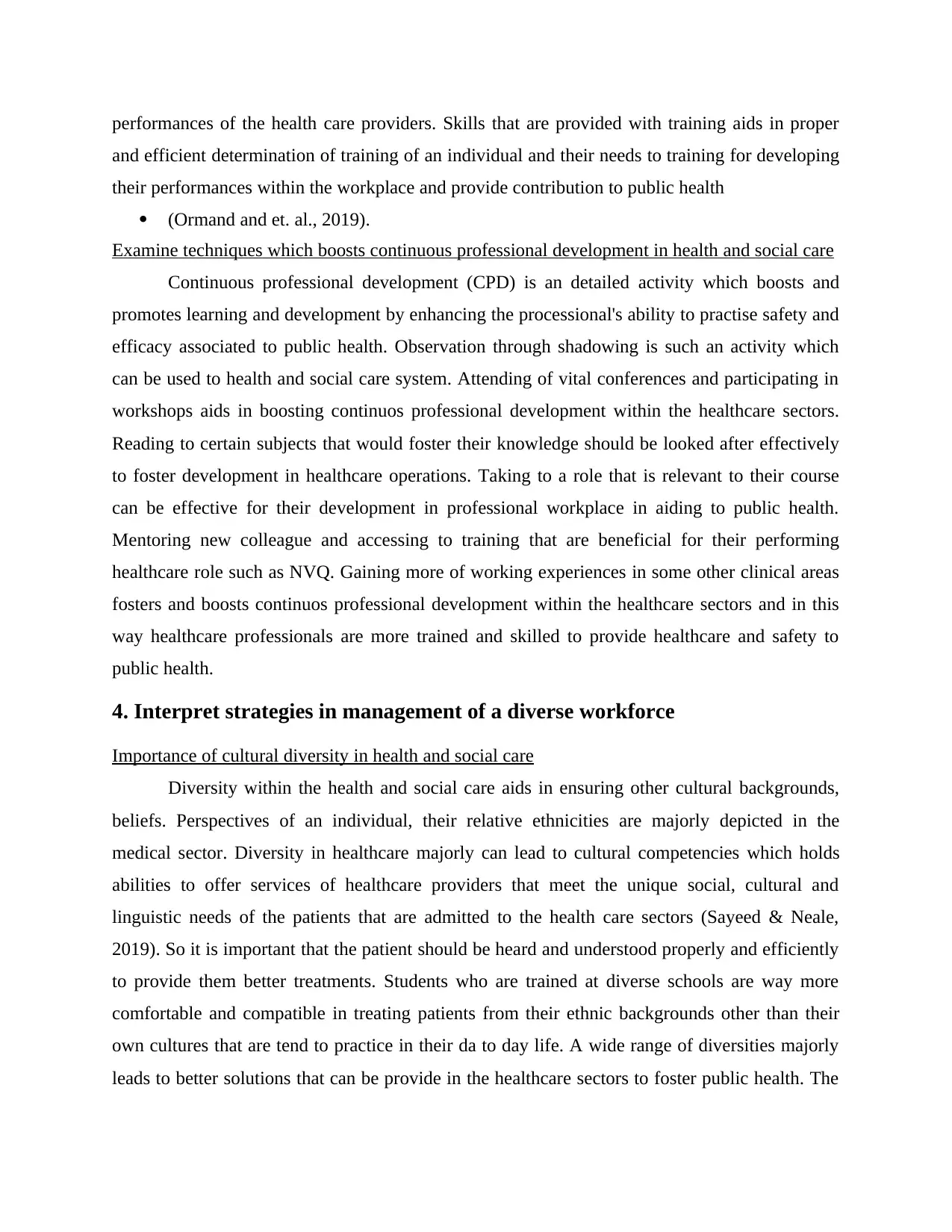
performances of the health care providers. Skills that are provided with training aids in proper
and efficient determination of training of an individual and their needs to training for developing
their performances within the workplace and provide contribution to public health
(Ormand and et. al., 2019).
Examine techniques which boosts continuous professional development in health and social care
Continuous professional development (CPD) is an detailed activity which boosts and
promotes learning and development by enhancing the processional's ability to practise safety and
efficacy associated to public health. Observation through shadowing is such an activity which
can be used to health and social care system. Attending of vital conferences and participating in
workshops aids in boosting continuos professional development within the healthcare sectors.
Reading to certain subjects that would foster their knowledge should be looked after effectively
to foster development in healthcare operations. Taking to a role that is relevant to their course
can be effective for their development in professional workplace in aiding to public health.
Mentoring new colleague and accessing to training that are beneficial for their performing
healthcare role such as NVQ. Gaining more of working experiences in some other clinical areas
fosters and boosts continuos professional development within the healthcare sectors and in this
way healthcare professionals are more trained and skilled to provide healthcare and safety to
public health.
4. Interpret strategies in management of a diverse workforce
Importance of cultural diversity in health and social care
Diversity within the health and social care aids in ensuring other cultural backgrounds,
beliefs. Perspectives of an individual, their relative ethnicities are majorly depicted in the
medical sector. Diversity in healthcare majorly can lead to cultural competencies which holds
abilities to offer services of healthcare providers that meet the unique social, cultural and
linguistic needs of the patients that are admitted to the health care sectors (Sayeed & Neale,
2019). So it is important that the patient should be heard and understood properly and efficiently
to provide them better treatments. Students who are trained at diverse schools are way more
comfortable and compatible in treating patients from their ethnic backgrounds other than their
own cultures that are tend to practice in their da to day life. A wide range of diversities majorly
leads to better solutions that can be provide in the healthcare sectors to foster public health. The
and efficient determination of training of an individual and their needs to training for developing
their performances within the workplace and provide contribution to public health
(Ormand and et. al., 2019).
Examine techniques which boosts continuous professional development in health and social care
Continuous professional development (CPD) is an detailed activity which boosts and
promotes learning and development by enhancing the processional's ability to practise safety and
efficacy associated to public health. Observation through shadowing is such an activity which
can be used to health and social care system. Attending of vital conferences and participating in
workshops aids in boosting continuos professional development within the healthcare sectors.
Reading to certain subjects that would foster their knowledge should be looked after effectively
to foster development in healthcare operations. Taking to a role that is relevant to their course
can be effective for their development in professional workplace in aiding to public health.
Mentoring new colleague and accessing to training that are beneficial for their performing
healthcare role such as NVQ. Gaining more of working experiences in some other clinical areas
fosters and boosts continuos professional development within the healthcare sectors and in this
way healthcare professionals are more trained and skilled to provide healthcare and safety to
public health.
4. Interpret strategies in management of a diverse workforce
Importance of cultural diversity in health and social care
Diversity within the health and social care aids in ensuring other cultural backgrounds,
beliefs. Perspectives of an individual, their relative ethnicities are majorly depicted in the
medical sector. Diversity in healthcare majorly can lead to cultural competencies which holds
abilities to offer services of healthcare providers that meet the unique social, cultural and
linguistic needs of the patients that are admitted to the health care sectors (Sayeed & Neale,
2019). So it is important that the patient should be heard and understood properly and efficiently
to provide them better treatments. Students who are trained at diverse schools are way more
comfortable and compatible in treating patients from their ethnic backgrounds other than their
own cultures that are tend to practice in their da to day life. A wide range of diversities majorly
leads to better solutions that can be provide in the healthcare sectors to foster public health. The
Paraphrase This Document
Need a fresh take? Get an instant paraphrase of this document with our AI Paraphraser
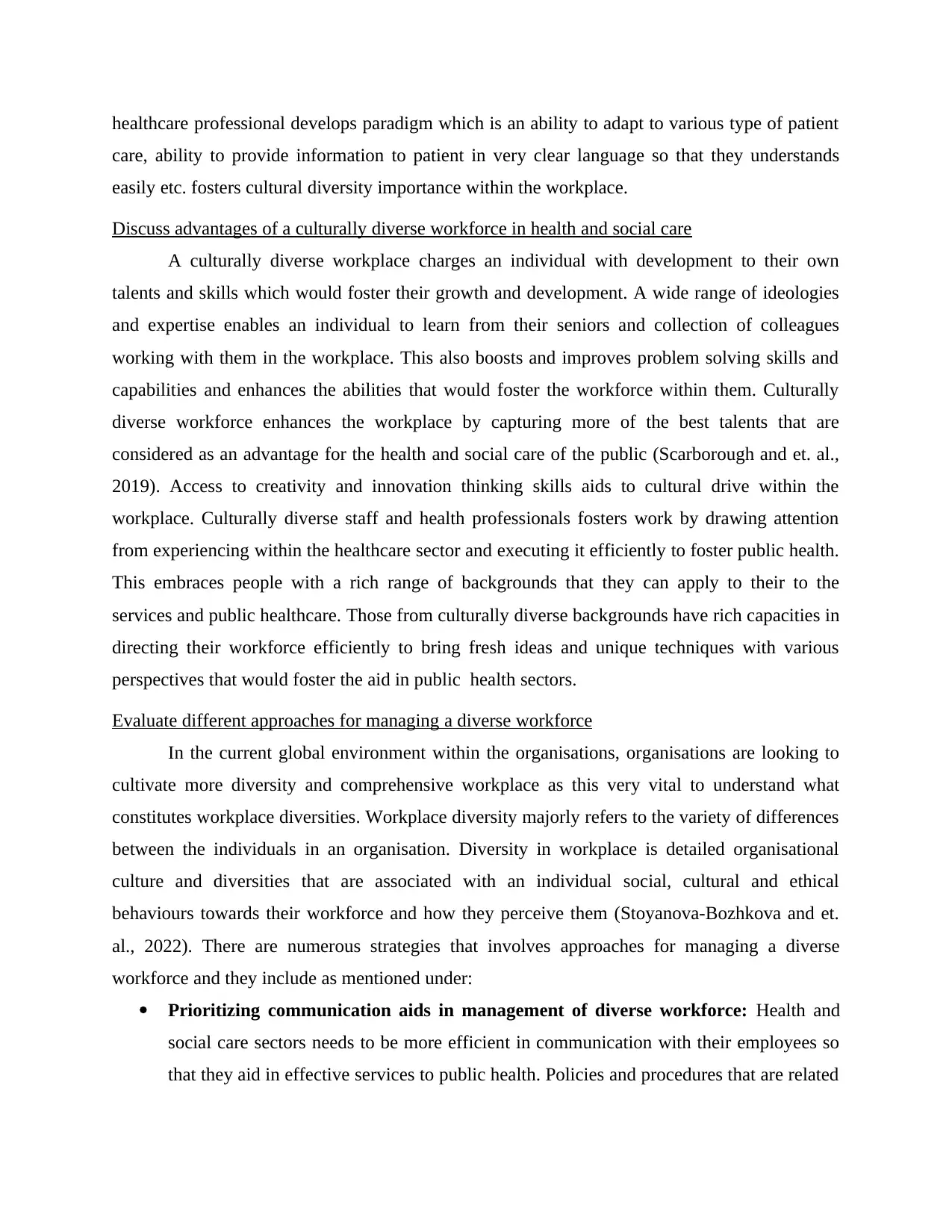
healthcare professional develops paradigm which is an ability to adapt to various type of patient
care, ability to provide information to patient in very clear language so that they understands
easily etc. fosters cultural diversity importance within the workplace.
Discuss advantages of a culturally diverse workforce in health and social care
A culturally diverse workplace charges an individual with development to their own
talents and skills which would foster their growth and development. A wide range of ideologies
and expertise enables an individual to learn from their seniors and collection of colleagues
working with them in the workplace. This also boosts and improves problem solving skills and
capabilities and enhances the abilities that would foster the workforce within them. Culturally
diverse workforce enhances the workplace by capturing more of the best talents that are
considered as an advantage for the health and social care of the public (Scarborough and et. al.,
2019). Access to creativity and innovation thinking skills aids to cultural drive within the
workplace. Culturally diverse staff and health professionals fosters work by drawing attention
from experiencing within the healthcare sector and executing it efficiently to foster public health.
This embraces people with a rich range of backgrounds that they can apply to their to the
services and public healthcare. Those from culturally diverse backgrounds have rich capacities in
directing their workforce efficiently to bring fresh ideas and unique techniques with various
perspectives that would foster the aid in public health sectors.
Evaluate different approaches for managing a diverse workforce
In the current global environment within the organisations, organisations are looking to
cultivate more diversity and comprehensive workplace as this very vital to understand what
constitutes workplace diversities. Workplace diversity majorly refers to the variety of differences
between the individuals in an organisation. Diversity in workplace is detailed organisational
culture and diversities that are associated with an individual social, cultural and ethical
behaviours towards their workforce and how they perceive them (Stoyanova-Bozhkova and et.
al., 2022). There are numerous strategies that involves approaches for managing a diverse
workforce and they include as mentioned under:
Prioritizing communication aids in management of diverse workforce: Health and
social care sectors needs to be more efficient in communication with their employees so
that they aid in effective services to public health. Policies and procedures that are related
care, ability to provide information to patient in very clear language so that they understands
easily etc. fosters cultural diversity importance within the workplace.
Discuss advantages of a culturally diverse workforce in health and social care
A culturally diverse workplace charges an individual with development to their own
talents and skills which would foster their growth and development. A wide range of ideologies
and expertise enables an individual to learn from their seniors and collection of colleagues
working with them in the workplace. This also boosts and improves problem solving skills and
capabilities and enhances the abilities that would foster the workforce within them. Culturally
diverse workforce enhances the workplace by capturing more of the best talents that are
considered as an advantage for the health and social care of the public (Scarborough and et. al.,
2019). Access to creativity and innovation thinking skills aids to cultural drive within the
workplace. Culturally diverse staff and health professionals fosters work by drawing attention
from experiencing within the healthcare sector and executing it efficiently to foster public health.
This embraces people with a rich range of backgrounds that they can apply to their to the
services and public healthcare. Those from culturally diverse backgrounds have rich capacities in
directing their workforce efficiently to bring fresh ideas and unique techniques with various
perspectives that would foster the aid in public health sectors.
Evaluate different approaches for managing a diverse workforce
In the current global environment within the organisations, organisations are looking to
cultivate more diversity and comprehensive workplace as this very vital to understand what
constitutes workplace diversities. Workplace diversity majorly refers to the variety of differences
between the individuals in an organisation. Diversity in workplace is detailed organisational
culture and diversities that are associated with an individual social, cultural and ethical
behaviours towards their workforce and how they perceive them (Stoyanova-Bozhkova and et.
al., 2022). There are numerous strategies that involves approaches for managing a diverse
workforce and they include as mentioned under:
Prioritizing communication aids in management of diverse workforce: Health and
social care sectors needs to be more efficient in communication with their employees so
that they aid in effective services to public health. Policies and procedures that are related
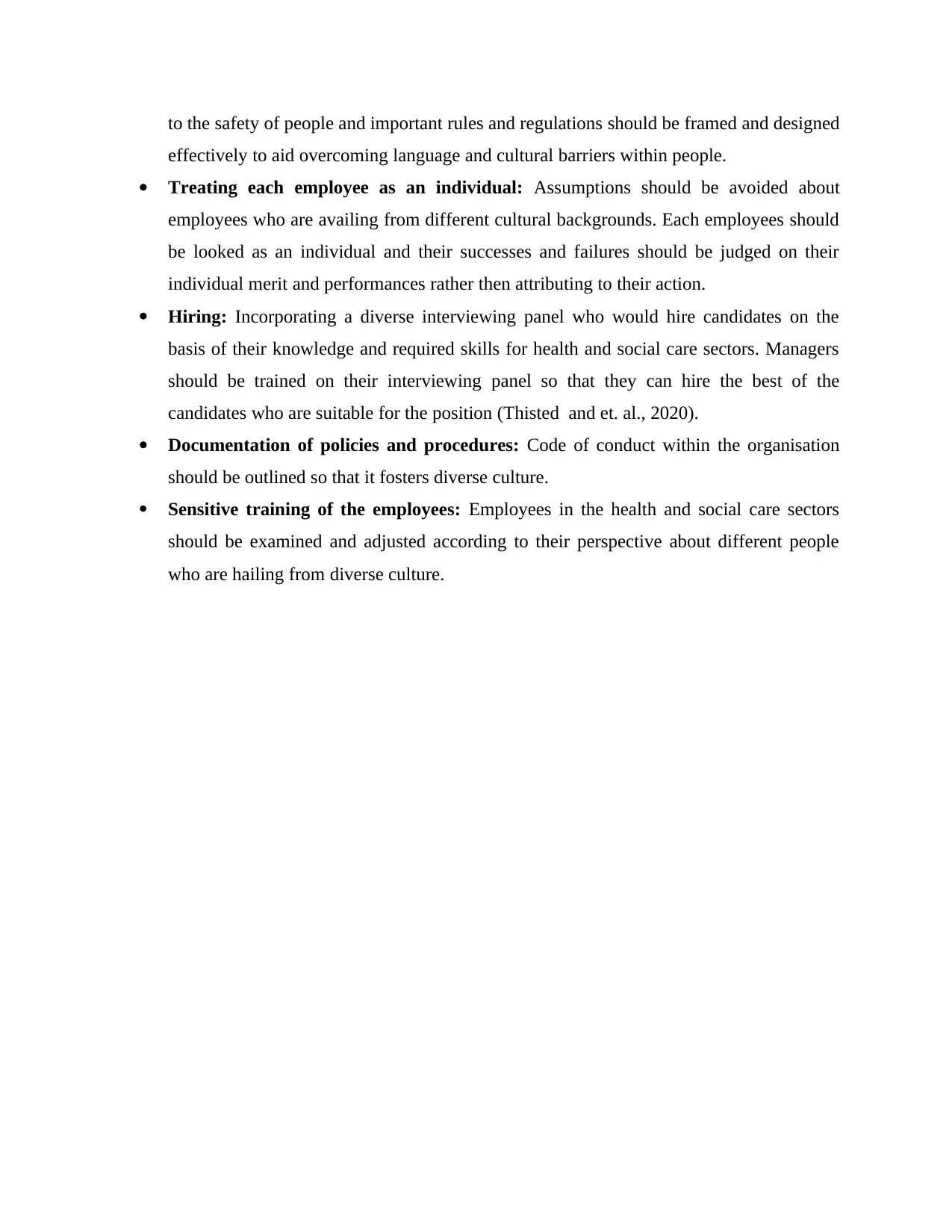
to the safety of people and important rules and regulations should be framed and designed
effectively to aid overcoming language and cultural barriers within people.
Treating each employee as an individual: Assumptions should be avoided about
employees who are availing from different cultural backgrounds. Each employees should
be looked as an individual and their successes and failures should be judged on their
individual merit and performances rather then attributing to their action.
Hiring: Incorporating a diverse interviewing panel who would hire candidates on the
basis of their knowledge and required skills for health and social care sectors. Managers
should be trained on their interviewing panel so that they can hire the best of the
candidates who are suitable for the position (Thisted and et. al., 2020).
Documentation of policies and procedures: Code of conduct within the organisation
should be outlined so that it fosters diverse culture.
Sensitive training of the employees: Employees in the health and social care sectors
should be examined and adjusted according to their perspective about different people
who are hailing from diverse culture.
effectively to aid overcoming language and cultural barriers within people.
Treating each employee as an individual: Assumptions should be avoided about
employees who are availing from different cultural backgrounds. Each employees should
be looked as an individual and their successes and failures should be judged on their
individual merit and performances rather then attributing to their action.
Hiring: Incorporating a diverse interviewing panel who would hire candidates on the
basis of their knowledge and required skills for health and social care sectors. Managers
should be trained on their interviewing panel so that they can hire the best of the
candidates who are suitable for the position (Thisted and et. al., 2020).
Documentation of policies and procedures: Code of conduct within the organisation
should be outlined so that it fosters diverse culture.
Sensitive training of the employees: Employees in the health and social care sectors
should be examined and adjusted according to their perspective about different people
who are hailing from diverse culture.
⊘ This is a preview!⊘
Do you want full access?
Subscribe today to unlock all pages.

Trusted by 1+ million students worldwide
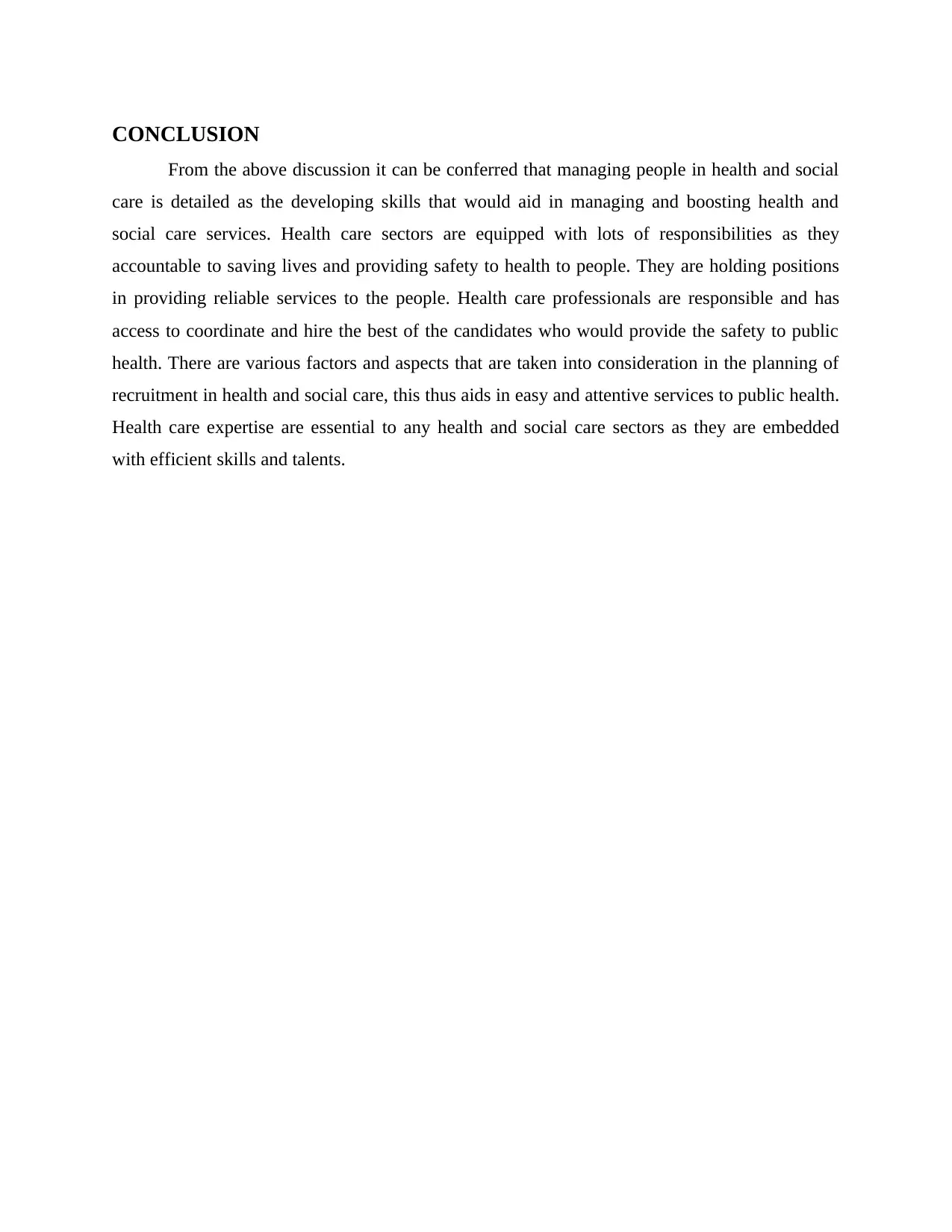
CONCLUSION
From the above discussion it can be conferred that managing people in health and social
care is detailed as the developing skills that would aid in managing and boosting health and
social care services. Health care sectors are equipped with lots of responsibilities as they
accountable to saving lives and providing safety to health to people. They are holding positions
in providing reliable services to the people. Health care professionals are responsible and has
access to coordinate and hire the best of the candidates who would provide the safety to public
health. There are various factors and aspects that are taken into consideration in the planning of
recruitment in health and social care, this thus aids in easy and attentive services to public health.
Health care expertise are essential to any health and social care sectors as they are embedded
with efficient skills and talents.
From the above discussion it can be conferred that managing people in health and social
care is detailed as the developing skills that would aid in managing and boosting health and
social care services. Health care sectors are equipped with lots of responsibilities as they
accountable to saving lives and providing safety to health to people. They are holding positions
in providing reliable services to the people. Health care professionals are responsible and has
access to coordinate and hire the best of the candidates who would provide the safety to public
health. There are various factors and aspects that are taken into consideration in the planning of
recruitment in health and social care, this thus aids in easy and attentive services to public health.
Health care expertise are essential to any health and social care sectors as they are embedded
with efficient skills and talents.
Paraphrase This Document
Need a fresh take? Get an instant paraphrase of this document with our AI Paraphraser
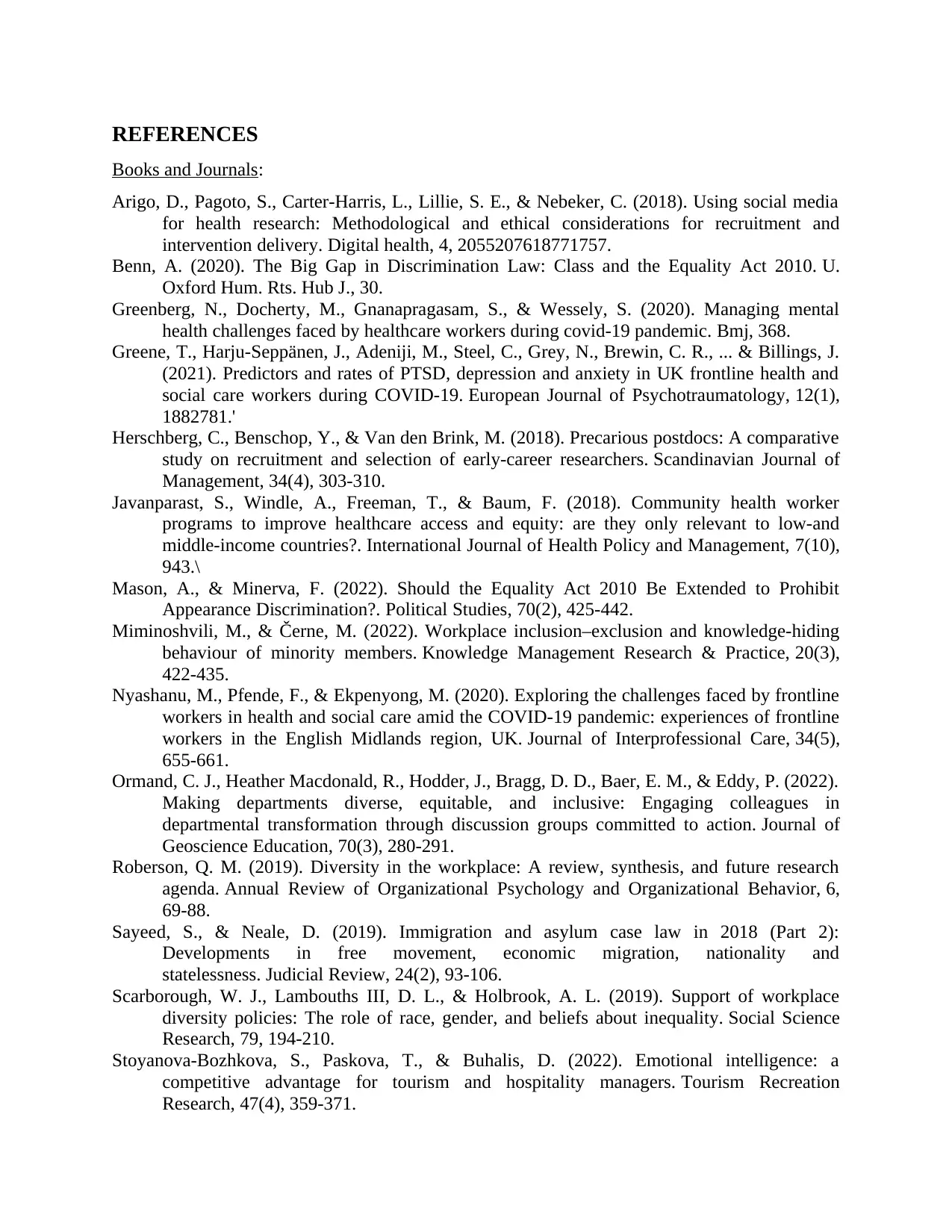
REFERENCES
Books and Journals:
Arigo, D., Pagoto, S., Carter-Harris, L., Lillie, S. E., & Nebeker, C. (2018). Using social media
for health research: Methodological and ethical considerations for recruitment and
intervention delivery. Digital health, 4, 2055207618771757.
Benn, A. (2020). The Big Gap in Discrimination Law: Class and the Equality Act 2010. U.
Oxford Hum. Rts. Hub J., 30.
Greenberg, N., Docherty, M., Gnanapragasam, S., & Wessely, S. (2020). Managing mental
health challenges faced by healthcare workers during covid-19 pandemic. Bmj, 368.
Greene, T., Harju-Seppänen, J., Adeniji, M., Steel, C., Grey, N., Brewin, C. R., ... & Billings, J.
(2021). Predictors and rates of PTSD, depression and anxiety in UK frontline health and
social care workers during COVID-19. European Journal of Psychotraumatology, 12(1),
1882781.'
Herschberg, C., Benschop, Y., & Van den Brink, M. (2018). Precarious postdocs: A comparative
study on recruitment and selection of early-career researchers. Scandinavian Journal of
Management, 34(4), 303-310.
Javanparast, S., Windle, A., Freeman, T., & Baum, F. (2018). Community health worker
programs to improve healthcare access and equity: are they only relevant to low-and
middle-income countries?. International Journal of Health Policy and Management, 7(10),
943.\
Mason, A., & Minerva, F. (2022). Should the Equality Act 2010 Be Extended to Prohibit
Appearance Discrimination?. Political Studies, 70(2), 425-442.
Miminoshvili, M., & Černe, M. (2022). Workplace inclusion–exclusion and knowledge-hiding
behaviour of minority members. Knowledge Management Research & Practice, 20(3),
422-435.
Nyashanu, M., Pfende, F., & Ekpenyong, M. (2020). Exploring the challenges faced by frontline
workers in health and social care amid the COVID-19 pandemic: experiences of frontline
workers in the English Midlands region, UK. Journal of Interprofessional Care, 34(5),
655-661.
Ormand, C. J., Heather Macdonald, R., Hodder, J., Bragg, D. D., Baer, E. M., & Eddy, P. (2022).
Making departments diverse, equitable, and inclusive: Engaging colleagues in
departmental transformation through discussion groups committed to action. Journal of
Geoscience Education, 70(3), 280-291.
Roberson, Q. M. (2019). Diversity in the workplace: A review, synthesis, and future research
agenda. Annual Review of Organizational Psychology and Organizational Behavior, 6,
69-88.
Sayeed, S., & Neale, D. (2019). Immigration and asylum case law in 2018 (Part 2):
Developments in free movement, economic migration, nationality and
statelessness. Judicial Review, 24(2), 93-106.
Scarborough, W. J., Lambouths III, D. L., & Holbrook, A. L. (2019). Support of workplace
diversity policies: The role of race, gender, and beliefs about inequality. Social Science
Research, 79, 194-210.
Stoyanova-Bozhkova, S., Paskova, T., & Buhalis, D. (2022). Emotional intelligence: a
competitive advantage for tourism and hospitality managers. Tourism Recreation
Research, 47(4), 359-371.
Books and Journals:
Arigo, D., Pagoto, S., Carter-Harris, L., Lillie, S. E., & Nebeker, C. (2018). Using social media
for health research: Methodological and ethical considerations for recruitment and
intervention delivery. Digital health, 4, 2055207618771757.
Benn, A. (2020). The Big Gap in Discrimination Law: Class and the Equality Act 2010. U.
Oxford Hum. Rts. Hub J., 30.
Greenberg, N., Docherty, M., Gnanapragasam, S., & Wessely, S. (2020). Managing mental
health challenges faced by healthcare workers during covid-19 pandemic. Bmj, 368.
Greene, T., Harju-Seppänen, J., Adeniji, M., Steel, C., Grey, N., Brewin, C. R., ... & Billings, J.
(2021). Predictors and rates of PTSD, depression and anxiety in UK frontline health and
social care workers during COVID-19. European Journal of Psychotraumatology, 12(1),
1882781.'
Herschberg, C., Benschop, Y., & Van den Brink, M. (2018). Precarious postdocs: A comparative
study on recruitment and selection of early-career researchers. Scandinavian Journal of
Management, 34(4), 303-310.
Javanparast, S., Windle, A., Freeman, T., & Baum, F. (2018). Community health worker
programs to improve healthcare access and equity: are they only relevant to low-and
middle-income countries?. International Journal of Health Policy and Management, 7(10),
943.\
Mason, A., & Minerva, F. (2022). Should the Equality Act 2010 Be Extended to Prohibit
Appearance Discrimination?. Political Studies, 70(2), 425-442.
Miminoshvili, M., & Černe, M. (2022). Workplace inclusion–exclusion and knowledge-hiding
behaviour of minority members. Knowledge Management Research & Practice, 20(3),
422-435.
Nyashanu, M., Pfende, F., & Ekpenyong, M. (2020). Exploring the challenges faced by frontline
workers in health and social care amid the COVID-19 pandemic: experiences of frontline
workers in the English Midlands region, UK. Journal of Interprofessional Care, 34(5),
655-661.
Ormand, C. J., Heather Macdonald, R., Hodder, J., Bragg, D. D., Baer, E. M., & Eddy, P. (2022).
Making departments diverse, equitable, and inclusive: Engaging colleagues in
departmental transformation through discussion groups committed to action. Journal of
Geoscience Education, 70(3), 280-291.
Roberson, Q. M. (2019). Diversity in the workplace: A review, synthesis, and future research
agenda. Annual Review of Organizational Psychology and Organizational Behavior, 6,
69-88.
Sayeed, S., & Neale, D. (2019). Immigration and asylum case law in 2018 (Part 2):
Developments in free movement, economic migration, nationality and
statelessness. Judicial Review, 24(2), 93-106.
Scarborough, W. J., Lambouths III, D. L., & Holbrook, A. L. (2019). Support of workplace
diversity policies: The role of race, gender, and beliefs about inequality. Social Science
Research, 79, 194-210.
Stoyanova-Bozhkova, S., Paskova, T., & Buhalis, D. (2022). Emotional intelligence: a
competitive advantage for tourism and hospitality managers. Tourism Recreation
Research, 47(4), 359-371.
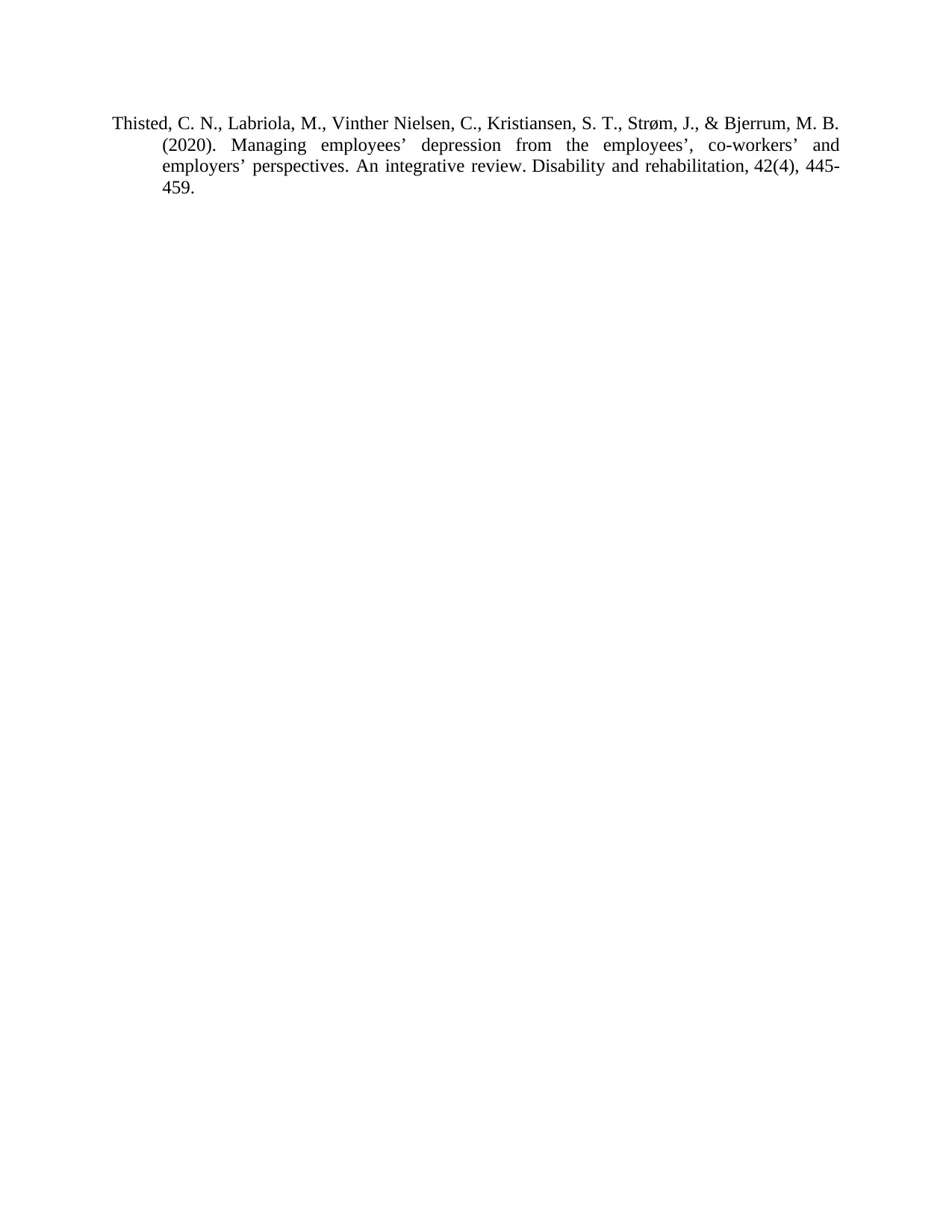
Thisted, C. N., Labriola, M., Vinther Nielsen, C., Kristiansen, S. T., Strøm, J., & Bjerrum, M. B.
(2020). Managing employees’ depression from the employees’, co-workers’ and
employers’ perspectives. An integrative review. Disability and rehabilitation, 42(4), 445-
459.
(2020). Managing employees’ depression from the employees’, co-workers’ and
employers’ perspectives. An integrative review. Disability and rehabilitation, 42(4), 445-
459.
⊘ This is a preview!⊘
Do you want full access?
Subscribe today to unlock all pages.

Trusted by 1+ million students worldwide
1 out of 12
Related Documents
Your All-in-One AI-Powered Toolkit for Academic Success.
+13062052269
info@desklib.com
Available 24*7 on WhatsApp / Email
![[object Object]](/_next/static/media/star-bottom.7253800d.svg)
Unlock your academic potential
Copyright © 2020–2025 A2Z Services. All Rights Reserved. Developed and managed by ZUCOL.





